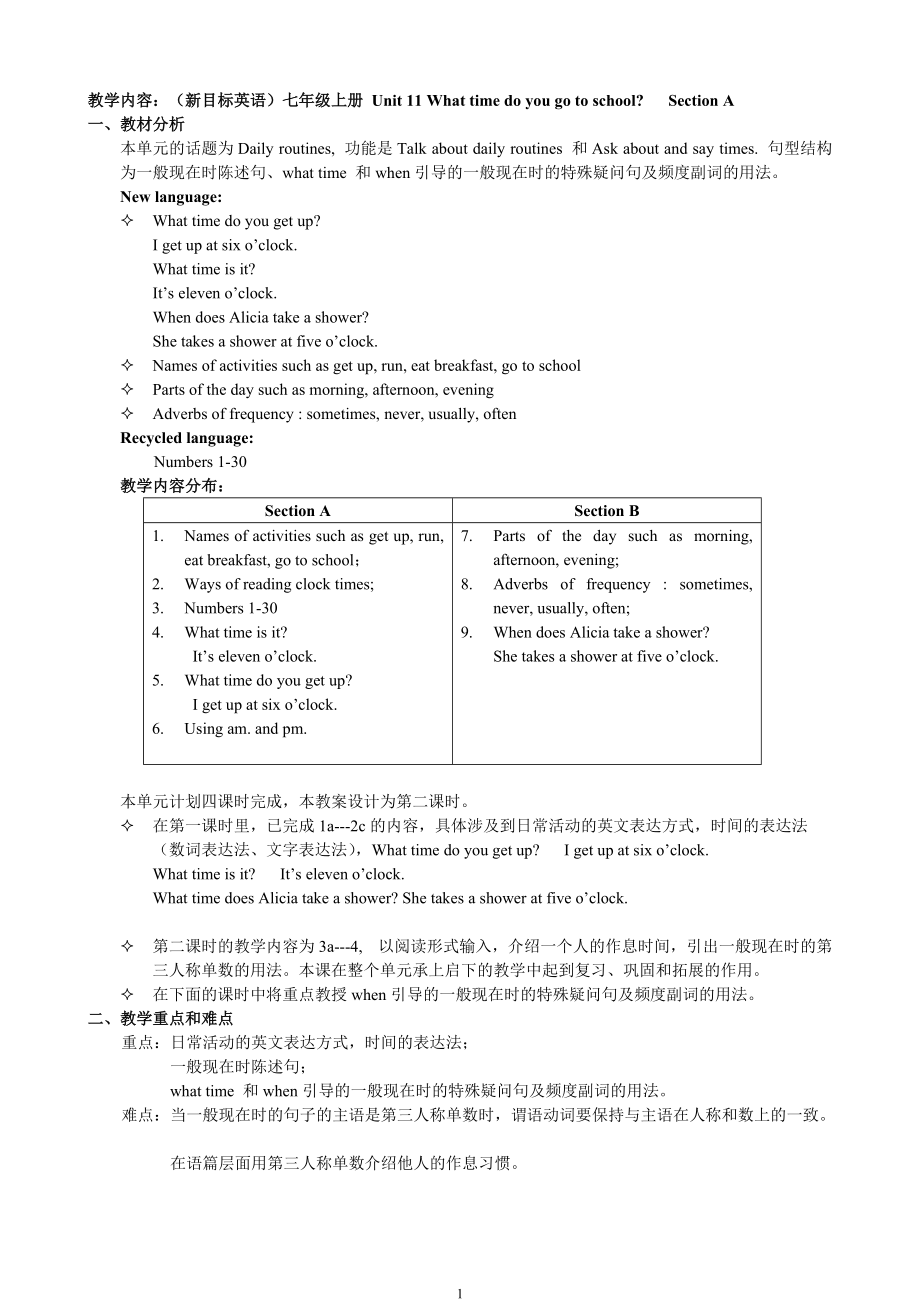《人教版新目標(biāo)英語(yǔ)七年級(jí)上冊(cè)Unit 11 What time do you go to schoolSection A說(shuō)課稿1》由會(huì)員分享�,可在線閱讀,更多相關(guān)《人教版新目標(biāo)英語(yǔ)七年級(jí)上冊(cè)Unit 11 What time do you go to schoolSection A說(shuō)課稿1(4頁(yè)珍藏版)》請(qǐng)?jiān)谘b配圖網(wǎng)上搜索�。
1、教學(xué)內(nèi)容:(新目標(biāo)英語(yǔ))七年級(jí)上冊(cè) Unit 11 What time do you go to school? Section A
一����、教材分析
本單元的話題為Daily routines, 功能是Talk about daily routines 和Ask about and say times. 句型結(jié)構(gòu)為一般現(xiàn)在時(shí)陳述句��、what time 和when引導(dǎo)的一般現(xiàn)在時(shí)的特殊疑問(wèn)句及頻度副詞的用法���。
New language:
What time do you get up?
I get up at six o’clock.
What time is it?
It’
2、s eleven o’clock.
When does Alicia take a shower?
She takes a shower at five o’clock.
Names of activities such as get up, run, eat breakfast, go to school
Parts of the day such as morning, afternoon, evening
Adverbs of frequency : sometimes, never, usually, often
Recycled language:
Number
3��、s 1-30
教學(xué)內(nèi)容分布:
Section A
Section B
1. Names of activities such as get up, run, eat breakfast, go to school���;
2. Ways of reading clock times;
3. Numbers 1-30
4. What time is it?
It’s eleven o’clock.
5. What time do you get up?
I get up at six o’clock.
6. Using am. and pm.
7. Parts of th
4����、e day such as morning, afternoon, evening;
8. Adverbs of frequency : sometimes, never, usually, often;
9. When does Alicia take a shower?
She takes a shower at five o’clock.
本單元計(jì)劃四課時(shí)完成��,本教案設(shè)計(jì)為第二課時(shí)����。
在第一課時(shí)里,已完成1a---2c的內(nèi)容����,具體涉及到日常活動(dòng)的英文表達(dá)方式��,時(shí)間的表達(dá)法(數(shù)詞表達(dá)法����、文字表達(dá)法)����,What time do you get up? I get
5��、up at six o’clock.
What time is it? It’s eleven o’clock.
What time does Alicia take a shower? She takes a shower at five o’clock.
第二課時(shí)的教學(xué)內(nèi)容為3a---4, 以閱讀形式輸入���,介紹一個(gè)人的作息時(shí)間���,引出一般現(xiàn)在時(shí)的第三人稱(chēng)單數(shù)的用法。本課在整個(gè)單元承上啟下的教學(xué)中起到復(fù)習(xí)���、鞏固和拓展的作用。
在下面的課時(shí)中將重點(diǎn)教授when引導(dǎo)的一般現(xiàn)在時(shí)的特殊疑問(wèn)句及頻度副詞的用法���。
二��、教學(xué)重點(diǎn)和難點(diǎn)
重點(diǎn):日?��;顒?dòng)的英文表達(dá)方式,時(shí)間的表達(dá)法��;
6、
一般現(xiàn)在時(shí)陳述句�;
what time 和when引導(dǎo)的一般現(xiàn)在時(shí)的特殊疑問(wèn)句及頻度副詞的用法。
難點(diǎn):當(dāng)一般現(xiàn)在時(shí)的句子的主語(yǔ)是第三人稱(chēng)單數(shù)時(shí)��,謂語(yǔ)動(dòng)詞要保持與主語(yǔ)在人稱(chēng)和數(shù)上的一致��。
在語(yǔ)篇層面用第三人稱(chēng)單數(shù)介紹他人的作息習(xí)慣��。
三��、學(xué)情分析
在七年級(jí)上冊(cè)的學(xué)習(xí)中�,一般現(xiàn)在時(shí)是最重要的語(yǔ)法項(xiàng)目,貫穿學(xué)期學(xué)習(xí)始終��。在前十個(gè)單元里���,學(xué)生們先后學(xué)習(xí)了be 動(dòng)詞的一般現(xiàn)在時(shí)的用法(陳述句�、一般疑問(wèn)句����、where和when引導(dǎo)的特殊疑問(wèn)句),行為動(dòng)詞的一般現(xiàn)在時(shí)的基本用法(陳述句���、一般疑問(wèn)句)���。
本班為英語(yǔ)實(shí)驗(yàn)班��,共有47名學(xué)生��。其中通過(guò)公共英語(yǔ)三級(jí)的有10人
7��、���;通過(guò)公共英語(yǔ)二級(jí)的有19人;通過(guò)公共英語(yǔ)一級(jí)的有6人��;其余12人為從派位生中經(jīng)過(guò)入學(xué)考試挑選出來(lái)的優(yōu)秀生
在以往的學(xué)習(xí)中���,我發(fā)現(xiàn)學(xué)生們主要的問(wèn)題集中出現(xiàn)在當(dāng)主語(yǔ)是第三人稱(chēng)單數(shù)時(shí)�,主謂不能保持一致���。大多數(shù)的同學(xué)能做到準(zhǔn)確運(yùn)用,余下的同學(xué)則處在不完全掌握的狀態(tài)�。雖然在講解時(shí)都能理解,但在實(shí)際運(yùn)用時(shí)還是容易忘了改變動(dòng)詞的形式�。
預(yù)測(cè)本課時(shí)的難點(diǎn)還將出現(xiàn)在主語(yǔ)是第三人稱(chēng)單數(shù)時(shí),主謂要保持一致上。
四���、設(shè)計(jì)思路
本課時(shí)的主要功能是談?wù)撍说淖飨⒘?xí)慣���,復(fù)習(xí)和鞏固第一課時(shí)中呈現(xiàn)的時(shí)間表達(dá)法、what time引導(dǎo)的一般現(xiàn)在時(shí)的特殊疑問(wèn)句及一般現(xiàn)在時(shí)的第三人稱(chēng)單數(shù)的用法�。要求學(xué)生能利用之
8、前掌握的關(guān)于日?�;顒?dòng)的詞匯并結(jié)合本單元目標(biāo)句型����,介紹他人的作息習(xí)慣。
本課為第二課時(shí)�,旨在復(fù)習(xí)、鞏固和拓展一般現(xiàn)在時(shí)的用法���。
本節(jié)課設(shè)計(jì)的理念是以英語(yǔ)新課程標(biāo)準(zhǔn)的語(yǔ)言培養(yǎng)目標(biāo)為依據(jù)����,從學(xué)生生活經(jīng)驗(yàn)和認(rèn)知水平出發(fā)���,涉及真實(shí)的情景���,采用讓學(xué)生體驗(yàn)���、實(shí)踐、參與�、合作與交流的學(xué)習(xí)方式,提高學(xué)生綜合語(yǔ)言運(yùn)用能力���。
教學(xué)過(guò)程流程圖:
導(dǎo)入(游戲?qū)朐掝})--- 閱讀語(yǔ)篇(語(yǔ)言輸入)--- 語(yǔ)言聚焦 (語(yǔ)言操練)---口頭報(bào)告(語(yǔ)言輸出)
五�、教學(xué)目標(biāo)
通過(guò)本課學(xué)習(xí)���,學(xué)生們能準(zhǔn)確運(yùn)用一般現(xiàn)在時(shí)第三人稱(chēng)單數(shù)介紹他人的作息習(xí)慣���。
六、教學(xué)資源
計(jì)算機(jī)��、演示文稿����、學(xué)案、游戲���、補(bǔ)
9、充閱讀材料
Stage 1 Lead---in
教師活動(dòng)
學(xué)生活動(dòng)
設(shè)計(jì)意圖
時(shí)間安排
Lead in the topic by playing the Bedtime Game.
Listen and play.
激發(fā)學(xué)生學(xué)習(xí)興趣
導(dǎo)入本課話題
3’
Stage 2 Reading input
教師活動(dòng)
學(xué)生活動(dòng)
設(shè)計(jì)意圖
時(shí)間安排
Assign the reading tasks;
Help Ss search for the answers;
C
10、heck the answers;
Evaluate Ss’ work
Activity I
l Read and answer:
1. What time does Scott usually go to bed?
2. What is the passage mainly about?
l Share the answers.
Activity II
l Read again and answer;
What is Scott’s job?
How do you know that?
l Fill in the chart.(附件一)
l Share with th
11����、e class.
Activity III
l Read and match; (附件二)
l Read and fill. (附件三)
感受體驗(yàn):
第三人稱(chēng)單數(shù)主語(yǔ)的一般現(xiàn)在時(shí)在真實(shí)語(yǔ)境中的應(yīng)用;
體驗(yàn)閱讀策略:
獲取基本信息�;
獲取具體信息;
根據(jù)閱讀內(nèi)容進(jìn)行推斷����。
為下一步活動(dòng)作
準(zhǔn)備
Stage 3 Practice
教師活動(dòng)
學(xué)生活動(dòng)
設(shè)計(jì)意圖
時(shí)間安排
Set the context by presenting several pictures; (American boy Tom’s daily routines)
12、
Assign the task;
Set an example;
Give instructions and check with concept questions;
Walk around and offer support if needed;
Make comments.
Activity I
l Observe and talk����;
l Make comments about Tom’s daily routines.
Activity II
l Work in pairs;
l Interview the partner about his or h
13、er daily routines on weekends;
l Fill in the chart; (附件四)
l Exchange information;
l Sum up the usage of the Simple Present Tense;(the third person)
滲透跨文化交際的意識(shí)�;
國(guó)際視野;
強(qiáng)化目標(biāo)語(yǔ)
引導(dǎo)學(xué)生觀察體驗(yàn)語(yǔ)言規(guī)律��、
進(jìn)行總結(jié)歸納的思維訓(xùn)練���;
七����、教學(xué)過(guò)程
Stage 4 Production and consolidation
教師活動(dòng)
14�、學(xué)生活動(dòng)
設(shè)計(jì)意圖
時(shí)間安排
Assign the writing task;
Set an example;
Activity I
l Write the report according to the interview;
l Share with the whole class;
l Evaluate and learn from each other; (附件五)
l Two minutes’ recall what should be paid more attention to while writing this report.
評(píng)價(jià)內(nèi)容:
是否有趣����?能否了解他人的作息習(xí)慣����?
評(píng)價(jià)目標(biāo)語(yǔ):
是否準(zhǔn)確使用?
Stage 4 Homework
4
 人教版新目標(biāo)英語(yǔ)七年級(jí)上冊(cè)Unit 11 What time do you go to schoolSection A說(shuō)課稿1
人教版新目標(biāo)英語(yǔ)七年級(jí)上冊(cè)Unit 11 What time do you go to schoolSection A說(shuō)課稿1

